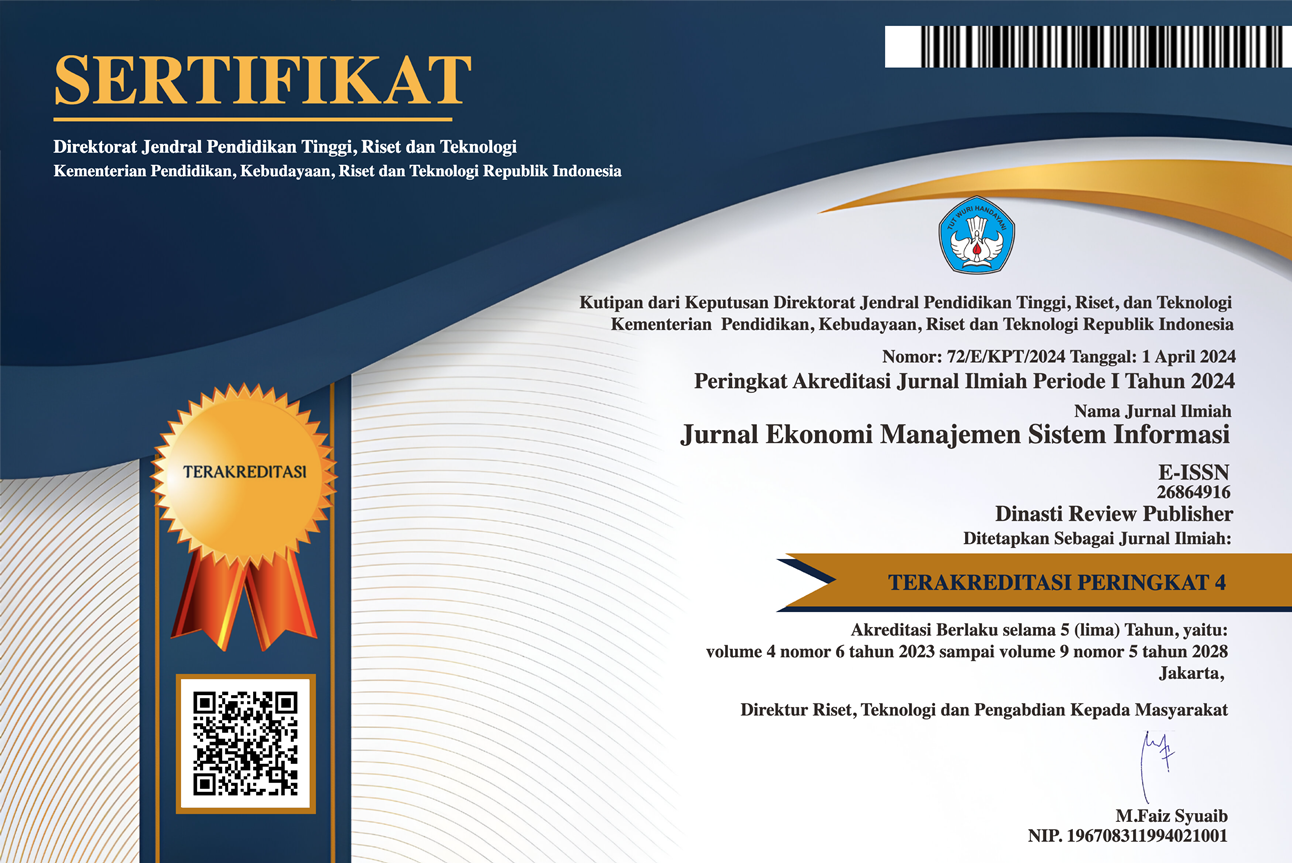Pengaruh Efek Pembingkaian Terhadap Pengambilan Keputusan Divestasi
DOI:
https://doi.org/10.38035/jemsi.v6i4.4614Keywords:
Pengambilan Keputusan, Divestasi, Framing Effect, Akuntansi Keperilakuan, EksperimenAbstract
Penelitian ini bertujuan untuk mengkaji pengaruh framing terhadap pengambilan keputusan divestasi. Penelitian berfokus pada proses pengambilan keputusan divestasi yang diduga dipengaruhi oleh perilaku manajer/direktur sebagai pengambil keputusan. Teori prospek adalah dasar teoritis utama dalam memahami bagaimana manajer menanggapi informasi yang berkaitan dengan keuntungan dan kerugian. Efek pembingkaian mengacu pada bagaimana penyajian informasi (positif atau negatif) mempengaruhi kecenderungan untuk membuat keputusan berisiko. Penelitian ini menggunakan pendekatan eksperimental untuk mengkaji pengaruh efek framing pada pengambilan keputusan divestasi. Hasil penelitian menunjukkan bahwa efek framing secara signifikan mempengaruhi pengambilan keputusan divestasi. Informasi yang disajikan dalam bingkai positif cenderung memicu perilaku menghindari risiko, sedangkan bingkai negatif meningkatkan perilaku mencari risiko. Penelitian ini diharapkan dapat membuka pembahasan lebih lanjut tentang pengaruh faktor psikologis dan perilaku dalam pengambilan keputusan strategis yang jarang dibahas dalam penelitian di bidang akuntansi manajemen. Selain itu, penelitian ini diharapkan dapat memberikan kontribusi yang signifikan terhadap literatur akademik terkait bagaimana penyajian informasi akuntansi manajemen yang berguna untuk pengambilan keputusan.
References
Bazerman, M. H. (1984). The Relevance of Kahneman and Tversky’s Concept of Framing to Organizational Behavior. Journal of Management, 10(3), 333–343. https://doi.org/10.1177/014920638401000307
Bergh, D. D., & Sharp, B. M. (2015). How Far Do Owners Reach Into the Divestiture Process? Blockholders and the Choice Between Spin-Off and Sell-Off. Journal of Management, 41(4), 1155–1183. https://doi.org/10.1177/0149206312456705
Blake, D. J., & Moschieri, C. (2017). Policy risk, strategic decisions and contagion effects: Firm?specific considerations. Strategic Management Journal, 38(3), 732–750. https://doi.org/10.1002/smj.2509
Brahmana, R. K., You, H.-W., & Yong, X.-R. (2021). Divestiture strategy, CEO power and firm performance. Management Research Review, 44(3), 418–436. https://doi.org/10.1108/MRR-04-2020-0196
Brauer, M. (2006). What Have We Acquired and What Should We Acquire in Divestiture Research? A Review and Research Agenda. Journal of Management, 32(6), 751–785. https://doi.org/10.1177/0149206306292879
Brauer, M. F., & Wiersema, M. F. (2012). Industry Divestiture Waves: How a Firm’s Position Influences Investor Returns. Academy of Management Journal, 55(6), 1472–1492. https://doi.org/10.5465/amj.2010.1099
Chang, L., Cheng, M., & Trotman, K. T. (2008). The effect of framing and negotiation partner’s objective on judgments about negotiated transfer prices. Accounting, Organizations and Society, 33(7–8), 704–717. https://doi.org/10.1016/j.aos.2008.01.002
Chong, V. K., Loy, C. Y., Masschelein, S., & Woodliff, D. R. (2018). The effect of performance evaluation schemes on predicted transfer prices: Do leadership tone and perceived fairness concerns matter? Management Accounting Research, 41, 11–19. https://doi.org/10.1016/j.mar.2018.02.003
Duhaime, I. M., & Schwenk, C. R. (1985). Conjectures on Cognitive Simplification in Acquisition and Divestment Decision Making. Academy of Management Review, 10(2), 287–295. https://doi.org/10.5465/amr.1985.4278207
Fehrenbacher, D., Roetzel, P. G., & Pedell, B. (2018). The influence of culture and framing on investment decision-making. Cross Cultural & Strategic Management, 25(4), 763–780. https://doi.org/10.1108/CCSM-10-2017-0139
Feldman, E. R. (2021). Restructuring and Divestitures. In Strategic Management (pp. 153–166). Oxford University PressNew York. https://doi.org/10.1093/oso/9780190090883.003.0009
Feldman, E. R., Amit, R., & Villalonga, B. (2016). Corporate divestitures and family control. Strategic Management Journal, 37(3), 429–446. https://doi.org/10.1002/smj.2329
Gertner, R., Powers, E., & Scharfstein, D. (2002). Learning about Internal Capital Markets from Corporate Spin?offs. The Journal of Finance, 57(6), 2479–2506. https://doi.org/10.1111/1540-6261.00503
Harwood, G. B., Pate, J. L., & Schneider, A. (1991). Budgeting decisions as a function of framing: an application of prospect theory’s reflection effect. Management Accounting Research, 2(3), 161–170. https://doi.org/10.1016/S1044-5005(91)70032-2
Hirsch, B., Reichert, B. E., & Sohn, M. (2017). The impact of clawback provisions on information processing and investment behaviour. Management Accounting Research, 37, 1–11. https://doi.org/10.1016/j.mar.2016.12.001
Ji, M., & Jiang, L. (2022). Aggressive CEOs and bank mergers and acquisitions. Journal of Contemporary Accounting & Economics, 18(3), 100318. https://doi.org/10.1016/j.jcae.2022.100318
Kahneman, D., Knetsch, J. L., & Thaler, R. H. (1991). Anomalies: The Endowment Effect, Loss Aversion, and Status Quo Bias. Journal of Economic Perspectives, 5(1), 193–206. https://doi.org/10.1257/jep.5.1.193
Kahneman, D., & Tversky, A. (1979). Prospect Theory: An Analysis of Decision under Risk. Econometrica, 47(2), 263. https://doi.org/10.2307/1914185
Karakaya, F. (2000). Market exit and barriers to exit: Theory and practice. Psychology and Marketing, 17(8), 651–668. https://doi.org/10.1002/1520-6793(200008)17:8<651::AID-MAR1>3.0.CO;2-K
Kartin, A. P., & Murniati, M. P. (2018). Responsibility On Risky Choice: Framing Effect On Investment Decision Making Of Individual Within The Group. South East Asia Journal of Contemporary Business, Economics and Law, 16, 1.
Kolev, K. D. (2016). To Divest or not to Divest: A Meta?Analysis of the Antecedents of Corporate Divestitures. British Journal of Management, 27(1), 179–196. https://doi.org/10.1111/1467-8551.12145
Kühberger, A. (1998). The Influence of Framing on Risky Decisions: A Meta-analysis. Organizational Behavior and Human Decision Processes, 75(1), 23–55. https://doi.org/10.1006/obhd.1998.2781
Levin, I. P., Schneider, S. L., & Gaeth, G. J. (1998). All Frames Are Not Created Equal: A Typology and Critical Analysis of Framing Effects. Organizational Behavior and Human Decision Processes, 76(2), 149–188. https://doi.org/10.1006/obhd.1998.2804
Moschieri, C., & Mair, J. (2008). Research on corporate divestitures: A synthesis. Journal of Management & Organization, 14(4), 399–422. https://doi.org/10.5172/jmo.837.14.4.399
Powell, T. C., Lovallo, D., & Fox, C. R. (2011). Behavioral strategy. Strategic Management Journal, 32(13), 1369–1386. https://doi.org/10.1002/smj.968
Roszkowski, M. J., & Snelbecker, G. E. (1990). Effects of “Framing” on measures of risk tolerance: Financial planners are not immune. Journal of Behavioral Economics, 19(3), 237–246. https://doi.org/10.1016/0090-5720(90)90029-7
Sandri, S., Schade, C., Mußhoff, O., & Odening, M. (2010). Holding on for too long? An experimental study on inertia in entrepreneurs’ and non-entrepreneurs’ disinvestment choices. Journal of Economic Behavior & Organization, 76(1), 30–44. https://doi.org/10.1016/j.jebo.2010.02.011
Shimizu, K. (2007). Prospect Theory, Behavioral Theory, and the Threat-Rigidity Thesis: Combinative Effects on Organizational Decisions to Divest Formerly Acquired Units. Academy of Management Journal, 50(6), 1495–1514. https://doi.org/10.5465/amj.2007.28226158
Simon, H. A. (1955). A Behavioral Model of Rational Choice. The Quarterly Journal of Economics, 69(1), 99. https://doi.org/10.2307/1884852
Tversky, A., & Kahneman, D. (1981). The Framing of Decisions and the Psychology of Choice. Science, 211(4481), 453–458. https://doi.org/10.1126/science.7455683
Twardawski, T., & Kind, A. (2023). Board overconfidence in mergers and acquisitions. Journal of Business Research, 165, 114026. https://doi.org/10.1016/j.jbusres.2023.114026
Wahyuni, S., & Hartono, J. (2019). Akuntansi Keperilakuan Pengantar (1st ed.). UPP STIM YKPN.
Wan, W. P., Chen, H. S., & Yiu, D. W. (2015). Organizational Image, Identity, and International Divestment: A Theoretical Examination. Global Strategy Journal, 5(3), 205–222. https://doi.org/10.1002/gsj.1101
Wang, Y. (2023). Behavioral Biases in Investment Decision-Making. Advances in Economics, Management and Political Sciences, 46(1), 140–146. https://doi.org/10.54254/2754-1169/46/20230330
Downloads
Published
How to Cite
Issue
Section
License
Copyright (c) 2025 Galant Victory, Fauzan Misra

This work is licensed under a Creative Commons Attribution 4.0 International License.
Hak cipta :
Penulis yang mempublikasikan manuskripnya di jurnal ini menyetujui ketentuan berikut:
- Hak cipta pada setiap artikel adalah milik penulis.
- Penulis mengakui bahwa Jurnal Ekonomi Manajemen Sistem Informasi (JEMSI) berhak menjadi yang pertama menerbitkan dengan lisensi Creative Commons Attribution 4.0 International (Attribution 4.0 International CC BY 4.0) .
- Penulis dapat mengirimkan artikel secara terpisah, mengatur distribusi non-eksklusif manuskrip yang telah diterbitkan dalam jurnal ini ke versi lain (misalnya, dikirim ke repositori institusi penulis, publikasi ke dalam buku, dll.), dengan mengakui bahwa manuskrip telah diterbitkan pertama kali di Jurnal Ekonomi Manajemen Sistem Informasi (JEMSI).











































































